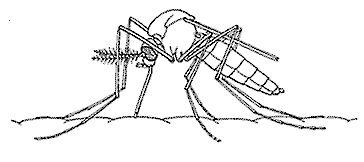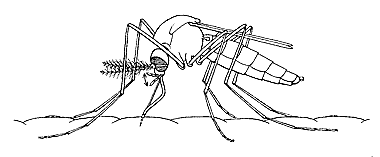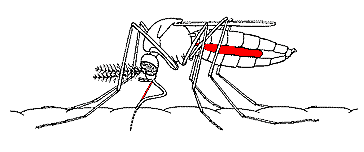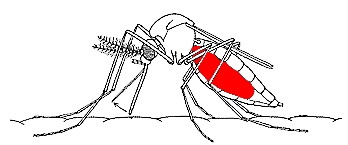Mosquitoes, Part 2
(more examples of mosquitoes skin diving)
Blood-Feeding Techniques of Mosquitoes
The mosquito is said to be an enterprising creature that never waits for an opening, but she always makes one and has a great depth of feeling.
To better understand the complexity of what is involved in the act of blood feeding, we need to know something about the anatomy of the mosquito’s proboscis and alimentary canal.
The probosis projects directly in front of the insect. It consists of a large, scaly outer lower lip called the labium, which terminates at the tip in two hairy lobes called the labella. The labium forms a deep trough in which is concealed a smaller bundle of long tapering pale yellow feeding stylets that are collectively called the fascicle. The largest stylet is the sharply pointed labrum, which forms an inverted gutter up which the blood is drawn.
At the side of the labrum are two long, thin mandibles. Under them are two much larger needle-like maxillae with fine saw-toothed tips. Under them in turn is a flattened stylet, the hypopharynx, down the center of which runs a single salivary canal. The fascicle acts as both a piercing mechanism and a food canal.

- When the mosquito is poised for the moment of piercing, it has all six legs on the surface of the victim’s skin, its hairy labella touching the skin and its maxillary palps raised.
- It is believed that after the mosquito spreads its labella the finely toothed maxillae of the fascicle literally saw their way into the tissue of the skin with very rapid back-and-forth movements.
- Next, the large labium is folded back like a hairpin. The skin is actually punctured without any obvious thrusting of the mosquito's body.
- About half the length of the fascicle is inserted into the skin. As it is inserted, the mosquito gradually shifts its legs closer to its body.
- It takes an average female mosquito about fifty seconds to insert her fascicle into the human skin, and unless she is interrupted (perhaps by being swatted by the victim!) she usually sucks blood for about two and a half minutes.
- When she has drunk her fill, she withdraws the fascicle rather quickly (in about five seconds).
- The procedure is to straighten her front legs, leaning slightly backward, and moving the labium from side to side.
- Once the fascicle has been removed from the skin, it springs upward and forward and then returns to the deep groove of the labium.
- When asked about the habits of mosquitoes, Dr. George B. Craig Jr., director of the University of Notre Dame’s Vector Biology Laboratory, responded with a question: "Which mosquito?"
- The Aedes vexans, the most common plague of Americans, both country and city, is different from Aedes excrucians of northern wooded areas, as well as from Aedes tormentor of the southern woods; Culex pipiens, the common house mosquito of the tropics; Coquillettidia perturbans, an inland swamp mosquito; Toxorhynchitis rutilus mosquitoes, which eat the larvae of Aedes aegypti, the yellow fever mosquito, the Anopheles, and so on down through 3 000 different species.
- To complicate matters even more, the species of mosquitoes that predominate vary widely from area to area, so that the type that hovers around a city bedroom or other parts of the home is likely to be quite different from the one that follows people around on the golf course or in the park.
- There are mosquitoes that rest during the day and emerge in the dim light of dawn and evening. Some feed at night, other during bright daylight; still others, like the vector of La Crosse encephalitis, are most active in late afternoon.
- Mosquitoes lay eggs in thousands of carefully selected places: tree holes, discarded tires, decorative fountains, flowerpot trays, elephant footprints, pitcher plants, empty cans, forest ponds, salt marshes, low spots in the yard; anywhere that water is likely to accumulate in the near future. It is said that some species of Aedes lay their eggs on dry ground that will be subject to future flooding, and the eggs may survive for as long as two years without water.
- The whole process from egg to blood-thirsty adult is accomplished in about ten days, and four to five days after her last blood meal, the female is ready to feed and lay again (about 100 at a time).



The feeding behavior and habits of mosquitoes varies widely from one species to the next.
End of Part 2 of 2
 Part 1, if you want it again.
Part 1, if you want it again.
 Go here for additional data about malaria and mosquitoes.
Go here for additional data about malaria and mosquitoes.
 There is also information about those who were responsible for finally determining
There is also information about those who were responsible for finally determining
the real causes of malaria.
A cross reference of other word family units that are related directly, or indirectly, with: "insects, bugs, worms; invertebrates": aphidi-; api-; ascari-; culci-; Dung Beetle Survival; Dung Beetles Important; Eating Worms; entomo-; formic-; Guinea worms; helmintho-; insecto-; Insects: Importance; isopter-; larvi-; lepidopter-; meliss-; mosquito; Mosquito, other Languages; Mosquitoes, Pt. 1; myrmeco-; scarab; scoleco-; sphec-; taeni-; termit-; vermo-.
